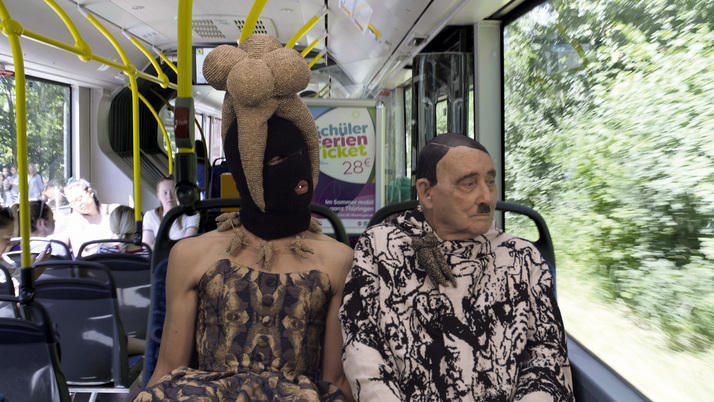-
From Current Issue
-
- Editor’s Letter Fire in the Heart
- Reviews I Gusti Ayu Kadek Murniasih
- Reviews 11th Seoul Mediacity Biennale: “One Escape at a Time”
- Dispatch Networked China
- One on One Monira Al Qadiri on Yukio Mishima
- Essays The rise of independent art spaces in pandemic-era Shanghai
- Features Tuan Andrew Nguyen
- Table of Contents
- Web Exclusives
- Archive
- Subscribe

R
E
V N
E
X
T
Installation view of GIL YEFMAN’s exhibition “Kibbutz Buchenwald,” at Tel Aviv Museum of Art, 2019. Photo by Elad Sarig. Courtesy the artists and Tel Aviv Museum of Art.
In line with the kibbutz’s communal ethos, Gil Yefman’s exhibition “Kibbutz Buchenwald” was created collaboratively, with Holocaust survivor and conceptual artist Dov Or-Ner, and Kuchinate, a collective of African women refugees who work with crochet. The namesake of the show was a cooperative founded in post-war Germany by ex-prisoners of the Buchenwald Nazi concentration camp. When the collective immigrated to Israel, they were encouraged by the Kibbutz Movement to take a more triumphant name, befitting the Zionist narrative that sees the Holocaust and the birth of the Jewish State as two conflicting events, and therefore considers a kibbutz titled after a Nazi camp to be an intolerable paradox.
Departing from this historical episode, the exhibition branched out to tackle lesser-known histories of World War II, and the conflict’s relationship to colonial oppression. “Kibbutz Buchenwald” opened with Hedgerow (all works 2018), a fence of crocheted vines crafted in public knitting circles under the guidance of Yefman and Kuchinate. The work alludes to a 1943 letter in which the commandant of the Auschwitz concentration and extermination camp ordered the specific placement of bushes to hide the crematoria. Hedgerow obscures the entrance to Yefman’s exhibition, thus hiding what proponents of the Israeli state’s hegemonic manner of remembrance may view as another kind of atrocity: art that dares to offer an alternative Holocaust commemoration centered on queer and marginalized voices.
Yefman and Or-Ner appear in the show as problematic caricatures: Or-Ner as Bad Renro,
a hybrid of the artist’s father and Adolf Hitler; and Yefman in blackface as Penelope, the daughter of a German officer and enslaved mother from colonial Namibia. The two star
in the show’s central video work, Bad Renro and Penelope at Kibbutz Buchenwald, in
which they aimlessly roam the camp, jump headfirst into the crematorium, and fly like superheroes above the location of Kibbutz Buchenwald, now known as Netzer Sereni
after Zionist leader Enzo Sereni. The camp (now a memorial site) and the kibbutz are Althusserian ideological state apparatuses—regulated spaces into which the characters are inserted as comical rulebreakers disrupting the interpellation these places impose.
Installation view of GIL YEFMAN and KUCHINATE COLLECTIVE’s Hedgerow, 2008, knitted installation with wool, Acrilan, felt, wire, embroidery thread, and gas pipes, 250 × 750 cm, at "Kibbutz Buchenwald,” Tel Aviv Museum of Art, 2019. Photo by Elad Sarig. Courtesy the artists and Tel Aviv Museum of Art.
Spectators can watch the video while sitting on Goethe Oak Bench, which references Buchenwald’s well-known tree, believed to mark the resting place of the German poet and thus spared by the Nazis who deforested the area before the camp’s construction. In the video, Bad Renro and Penelope revive the oak’s burnt stump with a seed of the resilient Ginkgo biloba, a species that served as a metaphor for intimacy in Goethe’s 1819 poem, and over a century later, in Hiroshima, survived the atomic bomb. This historical thicket embodies the intertwining of war and culture, and the characters’ grafting action offers a botanical resurrection instead of a nationalist one as an alternative narrative of survival.
The political instrumentalization of nature and femininity was a repeated motif in the show. God Full of Wombs, a felting work created
with Kuchinate, bears a monochrome image of wild flowers based on the design of a Nazi condolence card sent to bereaved German
women during the war. The work’s Hebrew title is a pun on “God Full of Mercy,” the Jewish funeral prayer, associated with Holocaust Remembrance and Memorial Day services. The work conjures the politicized portrayal—regardless of ideology or geography—of women as breeders of the nation’s soldiers.
The gender aspect of the show comes to the fore in Field Slave, a life-sized, androgynous knitted doll bearing multiple leaking breasts and penises. The work alludes to the dehumanizing misogyny of concentration camps’ brothels, where distinguished male prisoners were “rewarded” at the expense of abused and powerless female prisoners. At scheduled performances, Yefman inhabits the hollow doll, only
his eyes visible. The artist’s identity as a gay man—a group whose persecution by Nazis is severely under-acknowledged—adds another dimension to Field Slave.
Installation view of GIL YEFMAN’s Field Slave, 2018, knitted installation with wool, Acrilan, hair, jacquard fabric, fluorescent lamp, poster, two-way mirror, security camera, bed, monitor, looped video, dimensions variable, at "Kibbutz Buchenwald,” Tel Aviv Museum of Art, 2019. Photo by Elad Sarig. Courtesy the artist and Tel Aviv Museum of Art.
This sculpture is emblematic of the show, which utilized a fastidious aesthetic translation of historic narratives into soft textile to emphasize how those stories are woven by people and as such can be manipulated to exclude certain perspectives. Moreover, Yefman allows for a haptic, unmediated experience of remembrance implicit in the production of the works. Despite the occasional use of humor, far from downplaying the severity of the Holocaust, Yefman posits a deeper consideration of the event not as the official memorials to which it is reduced, but as a living, multifaceted, intrinsic part of the contemporary—in particular, Israeli—conscience, such that the concatenation “Kibbutz Buchenwald” may exist.
Gil Yefman’s “Kibbutz Buchenwald” is on view at the Tel Aviv Museum of Art until August 17, 2019.
To read more of ArtAsiaPacific’s articles, visit our Digital Library.



















